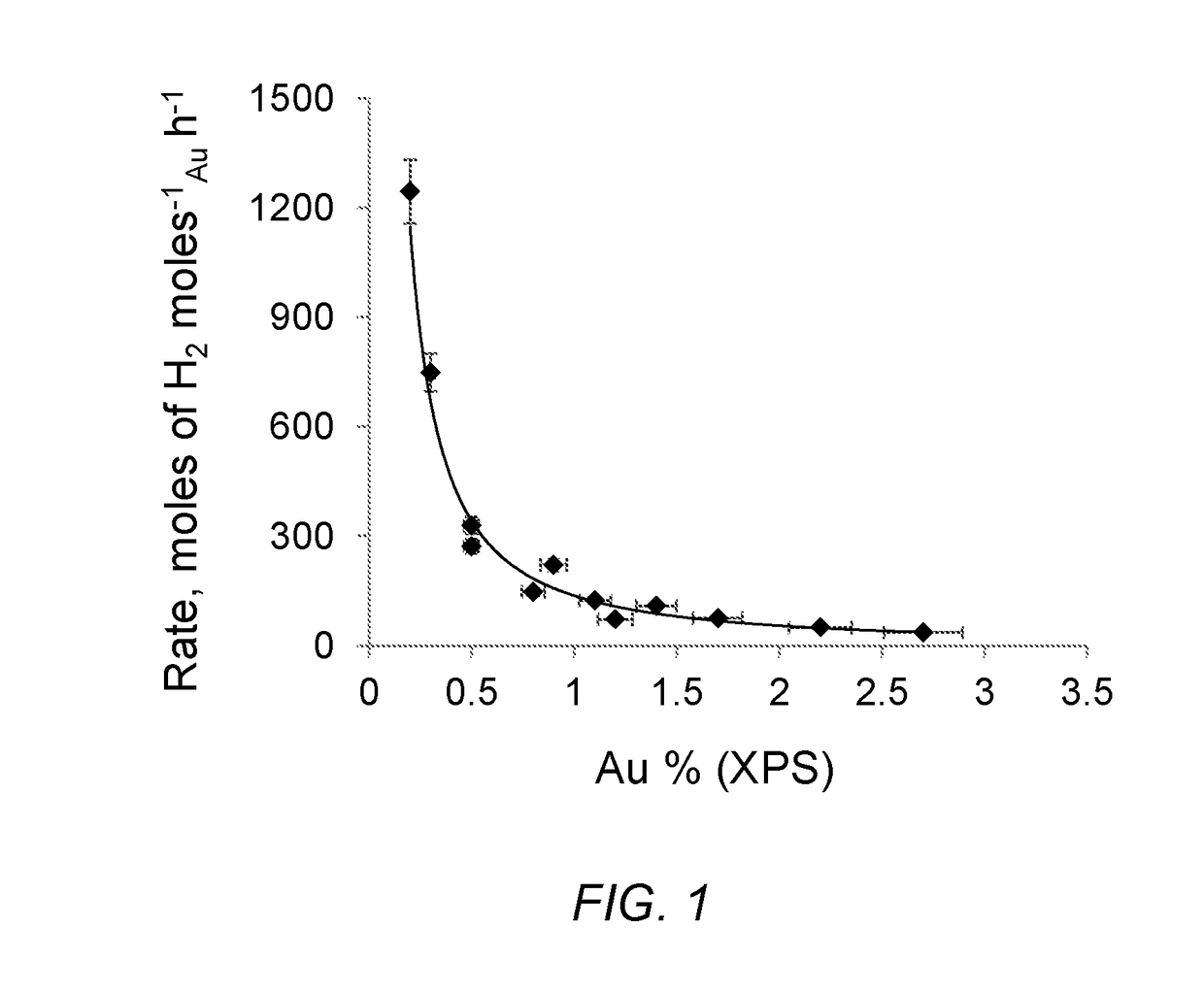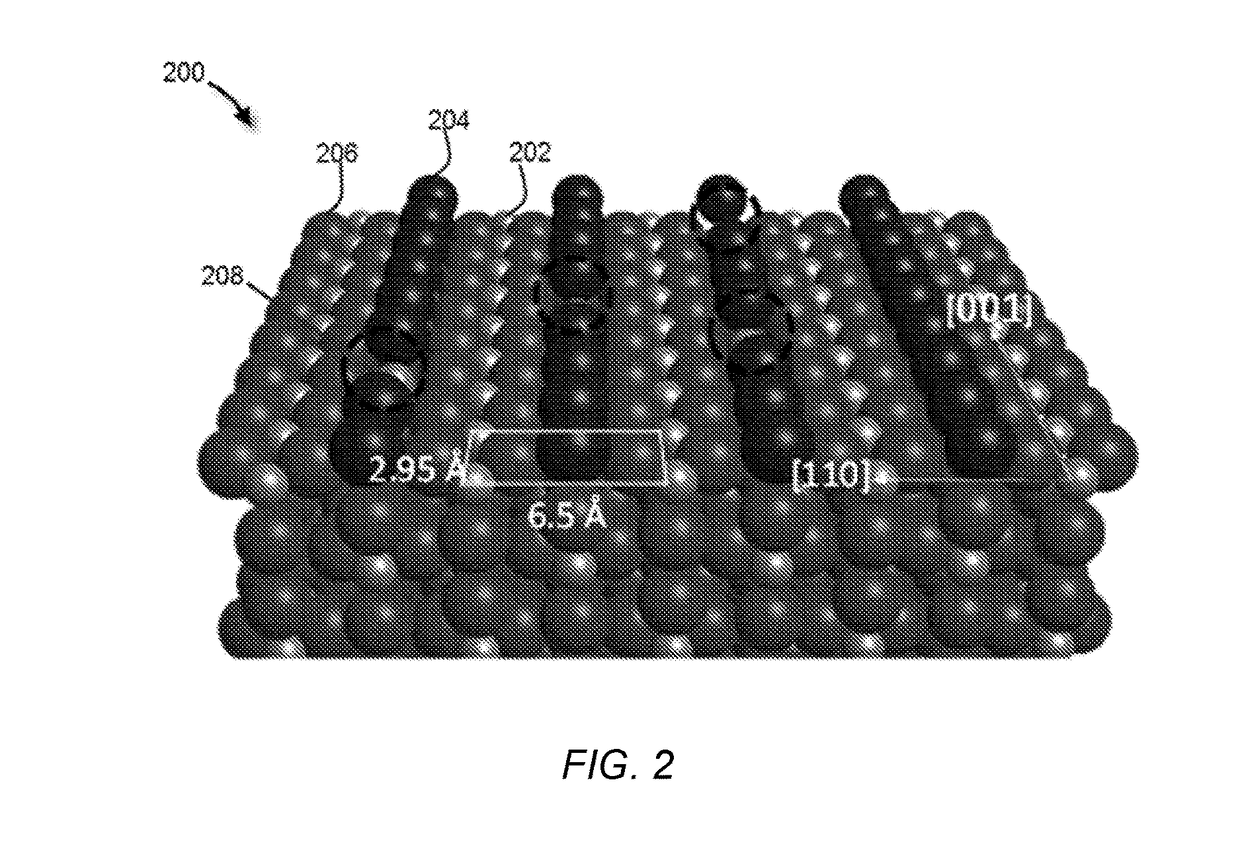Method of metallic clusters fabrication with desired size using scanning tunneling microscopy tip induced reactions
a scanning tunneling microscopy and atom induced reaction technology, applied in the direction of catalyst activation/preparation, metal/metal-oxide/metal-hydroxide catalyst, physical/chemical process catalyst, etc., can solve the problem of limited precision in the movement of atoms from one position to another, and achieve the effect of maximizing the efficiency of the resulting catalys
- Summary
- Abstract
- Description
- Claims
- Application Information
AI Technical Summary
Benefits of technology
Problems solved by technology
Method used
Image
Examples
example 1
Deposition of Metal (Au) on Metal Oxide Substrate (TiO2)
[0057]Au was deposited onto TiO2 (110) using physical vapor deposition (PVD) at a sample temperature of 300 K. The deposition source consisted of a tantalum filament wrapped around an Au rod, which was resistively heated. On heating, Au atoms were emitted from the AU sample, directed towards, and adsorbed onto the TiO2 (110).
example 2
Characterization Metal Oxide Substrate (TiO2) and of Metal (Au) Deposited On The TiO2
[0058]FIG. 5 is a STM image of the rutile TiO2 (110) clean surface. Alternating bright rows 502 are titanium and dark rows 504 are oxygen. Oxygen vacancies 506 are observed as bright spots along the dark lines (i.e., bridging two bright lines). Because there was one bridging O vacancy in each unit cell (0.295×0.65 nm2) the amount of surface oxygen vacancies was calculated from the STM image to be about 10%.
[0059]FIG. 6 depicts a STM image of a TiO2 (110) surface on which Au was deposited at 300 K. The image was 50×50 nm2 topographic STM image of the TiO2 (110) surface recorded at 78 K, with Au being dosed at 300 K. The TiO2 (110) surface includes Au1 atoms 602 and Au3 particles 604. A 1×2 reconstruction precursor (boxed section) was recorded using a 1.2 V bias voltage and a 0.01 nA tunneling current. Small particles of Au were observed to be distributed homogeneously over the terraces of the substr...
example 3
Transferring Metal Atoms
[0063]A −2 V pulse at 50 pA was applied on a Au1 atom on top of an oxygen vacancy to move the Au1 atom to another Au1 atom on top of an oxygen vacancy and form a Au2 species on an oxygen vacancy. FIGS. 11A and 11B depict STM images of STM tip induction of Au1 atom before pulsing and after pulsing. FIG. 11A depicts pulsing of first Au1 atom 1102 before pulsing. In FIG. 11A, atom 1102 is adjacent to a second Au1 atom 1104. During pulsing, the first Au1 atom 1102 moved toward second Au1 atom 1104 as shown by the arrow. Additional Au1 atoms were also observed to move upon pulsing. After pulsing, Au2 species 1106 was formed from the first Au1 atom 1102 and the second Au1 atom1104. FIG. 12 depicts a scan of current as a function of time upon pulsing the Au1 atom. As seen in FIG. 12, a sharp decrease in the current (I) that occurred after about 340 ms. Without wishing to be bound by theory, it is believed that the change (decrease) in current (due to a decrease in t...
PUM
| Property | Measurement | Unit |
|---|---|---|
| Time | aaaaa | aaaaa |
| Time | aaaaa | aaaaa |
| Current | aaaaa | aaaaa |
Abstract
Description
Claims
Application Information
 Login to View More
Login to View More - R&D
- Intellectual Property
- Life Sciences
- Materials
- Tech Scout
- Unparalleled Data Quality
- Higher Quality Content
- 60% Fewer Hallucinations
Browse by: Latest US Patents, China's latest patents, Technical Efficacy Thesaurus, Application Domain, Technology Topic, Popular Technical Reports.
© 2025 PatSnap. All rights reserved.Legal|Privacy policy|Modern Slavery Act Transparency Statement|Sitemap|About US| Contact US: help@patsnap.com



